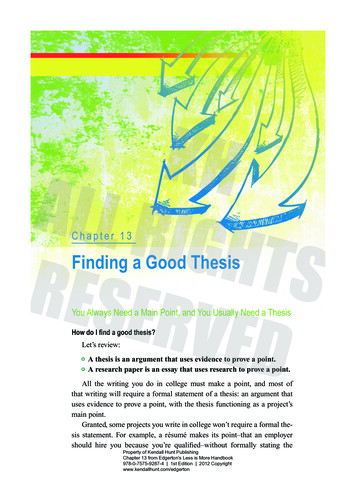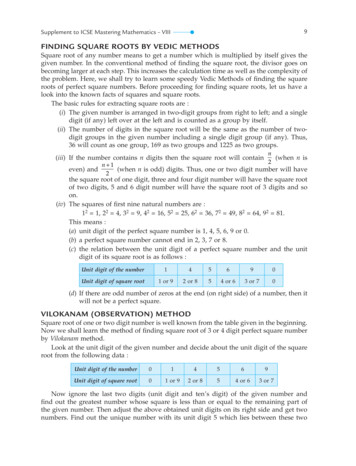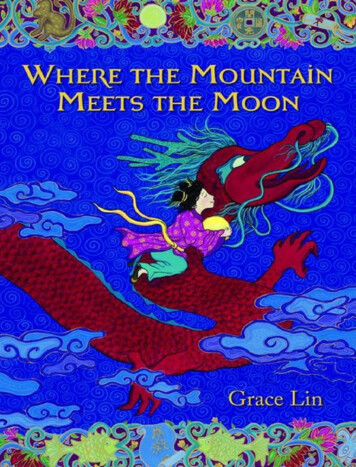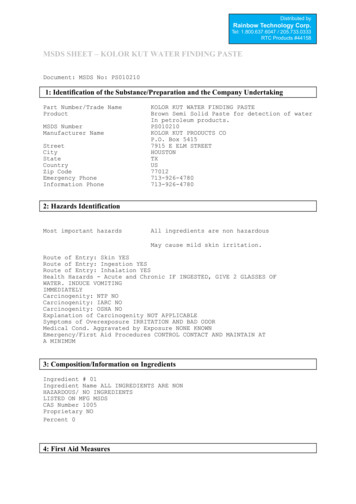
Transcription
Chapter 13Finding a Good ThesisYou Always Need a Main Point, and You Usually Need a ThesisHow do I find a good thesis?Let’s review: A thesis is an argument that uses evidence to prove a point. A research paper is an essay that uses research to prove a point.All the writing you do in college must make a point, and most ofthat writing will require a formal statement of a thesis: an argument thatuses evidence to prove a point, with the thesis functioning as a project’smain point.Granted, some projects you write in college won’t require a formal thesis statement. For example, a résumé makes its point–that an employershould hire you because you’re qualified–without formally stating theProperty of Kendall Hunt PublishingChapter 13 from Edgerton's Less is More Handbook978-0-7575-9287-4 1st Edition 2012 Copyrightwww.kendallhunt.com/edgertonK10924 Edgerton CH13.indd 25912/15/11 2:03 PM
Finding a Good Thesis267So where do I start?Look for that connection with a topic–emotional, intellectual, creative,or biographical.Maybe your grandparents survived the Great Depression. Or you’re ahistory major or have read a book about Franklin D. Roosevelt. Whatever,“The Great Depression and the Movies” is a rich topic, ripe with subtopics, since many movies in the 1930s reacted to economic hardships, just asHollywood turned out a number of movies through the 1940s and 1950sshaped by World War II.Women and the Movies is another rich topic, also ripe with subtopics,from women directors to a decade-by-decade examination of stereotypicalsex symbols.And if you turn to “Race, Ethnicity, Gender, and the Movies” becauseyou want to learn more about, say, the work of African-Americans in thefilm industry, it won’t be difficult to narrow the topic.How do I narrow a topic?You divide it into subtopics until you reach one that fits your project.What makes a good “fit”?A good topic fits the number of pages you have to write.Remember these two principles: A big topic more questions to ask about it a long project A small topic fewer questions to ask about it a short projectFor example, the following small topic (your wish for a new roommate)raises just one main or thesis question (Why do I want a new roommate?)and one “pre-question” (What does “obnoxious” mean?):I need a new roommate because my current roommate is obnoxious.Thus you need no more than a page or two to answer both questions.But consider this big topic:Global corporations threaten the welfare of the world’s poor because they put an disproportionate balance of wealth into thehands of the rich.Property of Kendall Hunt PublishingChapter 13 from Edgerton's Less is More Handbook978-0-7575-9287-4 1st Edition 2012 Copyrightwww.kendallhunt.com/edgertonK10924 Edgerton CH13.indd 26712/15/11 2:03 PM
268The Less-Is-More Handbook: A Guide to College WritingYou can reduce it to one main question, the thesis question,Why do global corporations threaten the welfare of the world’spoor?but the topic still triggers a number of pre-questions (What is a “globalcorporation”? What defines “poor”? What defines “disproportionate”?What defines “wealth” and “rich”?). These pre-questions will requiremany paragraphs to answer.In other words, even if you narrow a topic to a thesis question, youmust make sure that it doesn’t trigger too many “pre-questions” that youhave to deal with before you can answer the thesis question.So in terms of a good fit, what’s the difference between a big topic and asmall topic?It’s the number of questions you can ask about it. That number determines how well the topic fits the project.After I begin to narrow a topic, when do I stop?Narrow the topic until you end up with just one main question to askabout it.I don’t understand what you mean by “main question.” Won’t I always beable to ask questions about a topic?In its shortest form, the main question is your thesis question. After narrowing your topic to get rid of questions, it is the one remainingquestion–the main question. Don’t confuse the main question with prequestions or subtopic questions.Please! No jargon. Now I’m really confused. Main question? Thesis question? Pre-question? Subtopic question?The main question is your thesis question; it’s the question you answerin the thesis. A pre-question is a question triggered by words in the thesis;you must answer it before you can answer the thesis question. A subtopicquestion is a question you ask of subtopics of your main topic; you ask itto develop the Body.Property of Kendall Hunt PublishingChapter 13 from Edgerton's Less is More Handbook978-0-7575-9287-4 1st Edition 2012 Copyrightwww.kendallhunt.com/edgertonK10924 Edgerton CH13.indd 26812/15/11 2:04 PM
Putting the Research Paper Together279part of the revision process. (See the discussion of the reverse outline,Chapter 8–Revision.)Using Sources: When? How Many?When should I use my sources?Use a source each time you argue a point. Remember, sources includeboth primary and secondary. You may, for example, make a claim about aline in a poem. At that point, you should quote from the poem (a primarysource), and, if it seems apt, quote from a critical article (a secondarysource) about the poem.For a five-page paper, how many sources per page?Tricky problem: On the one hand, a research paper can’t be a cut-andpaste string of quotations. If each page has more quotation than you, you’rein trouble. On the other hand, a research paper needs research–just the loneparaphrase or quotation won’t work.In general, limit your sources to one or two per paragraph. Keep summaries, paraphrases, and–especially–quotations short: no more than twoor three sentences. If you have to go to a hefty indented quotation, then doit. But your readers won’t be pleased by a paper that uses paragraph-longquotations on every page. Keep your interpretation, not the sources, in thespotlight.Using Sources: How to Introduce ThemHow do I introduce summaries, paraphrases and–especially–quotationsinto the paper?The rule here is Never just drop in a source; set it up with a transition.Method?Write a transition from your last sentence to the quotation.Property of Kendall Hunt PublishingChapter 13 from Edgerton's Less is More Handbook978-0-7575-9287-4 1st Edition 2012 Copyrightwww.kendallhunt.com/edgertonK10924 Edgerton CH14.indd 27912/15/11 2:05 PM
280The Less-Is-More Handbook: A Guide to College WritingDropped-in quotation—AVOID:Movies have long shocked audiences for a variety of reasons, mostof which involve breaking taboos. “Significantly, films that exist outside of the multiplex mainstream often traffic in representations ofsuch taboo breaking” (Cline and Weiner xvii).Revision with a transition to set up the quotation—USE:Movies have long shocked audiences for a variety of reasons, mostof which involve breaking societal taboos. Some movies shock byaccident; others do it on purpose. Lacking Hollywood productionvalues, low-budget movies use shock to sell tickets. As Cline andWeiner point out in From the Arthouse to the Grindhouse: “Significantly, films that exist outside of the multiplex mainstream oftentraffic in representations of such taboo breaking” (xvii).TRANSITION TIPNote that the previous transition has two jobs:1. To support the research paper’s claim that some movies “useshock to sell tickets.”2. To set up an important implication in the quoted passage: thatlow-budget, non-Hollywood movies break taboos to make up for“mainstream” production values that sell tickets in the multiplex.Dropped-in summary—AVOID:Movies have long shocked audiences for a variety of reasons, mostof which involve breaking societal taboos. Some movies made outside Hollywood have a role: to shock viewers by challenging socialnorms. Some non-Hollywood movies that initially shock, like 1954'snotorious Salt of the Earth (directed by Herbert Biberman), may appear tame to a later audience (Cline and Weiner xvii).Revision with a transition to set up the summary—USE:Movies have long shocked audiences for a variety of reasons, mostof which involve breaking societal taboos. According to Cline andProperty of Kendall Hunt PublishingChapter 13 from Edgerton's Less is More Handbook978-0-7575-9287-4 1st Edition 2012 Copyrightwww.kendallhunt.com/edgertonK10924 Edgerton CH14.indd 28012/15/11 2:06 PM
282The Less-Is-More Handbook: A Guide to College WritingTRANSITION TIPPut a source attribution for a summary, paragraph, or quotation in one ofthree places:1. Before: As Cline and Weiner point out in From the Arthouse to theGrindhouse: “Significantly, films that exist outside of the multiplexmainstream often traffic in representations of such taboo breaking”(xvii).2. In the middle. “Significantly, films that exist outside of the multiplexmainstream,” as Cline and Weiner point out in From the Arthouseto the Grindhouse, “often traffic in representations of such taboobreaking” (xvii).3. At the end: “Significantly, films that exist outside of the multiplexmainstream often traffic in representations of such taboo breaking,”as Cline and Weiner point out in From the Arthouse to the Grindhouse(xvii).TRANSITION TIPTo integrate a source with a sentence, use brackets to:1. Change verbs for consistency.Cline and Weiner contend that the general responsetoward Salt of the Earth “among certain powerfulindividuals and factions [makes] it tempting to say thatit is, perhaps, the most controversial film ever made”(xvii). [Makes replaces make in the original.]2. Insert capital letters.“[T]he reactions it provoked among certain powerfulindividuals and factions make it tempting to say thatit is, perhaps, the most controversial film ever made”(Cline and Weiner xvii). [The capital T replaces alower-case t in the original.]3. Insert explanatory words.As Cline and Weiner assert, “[Salt of the Earth]provoked [a negative response] among certainpowerful individuals and factions” (xvii). [The insertedtitle replaces it in the original; the second insertioncompletes the meaning.]Property of Kendall Hunt PublishingChapter 13 from Edgerton's Less is More Handbook978-0-7575-9287-4 1st Edition 2012 Copyrightwww.kendallhunt.com/edgertonK10924 Edgerton CH14.indd 28212/15/11 2:07 PM
Putting the Research Paper Together283When do I use those periods . . . ellipsis? Ellipses?Ellipsis is the singular; ellipses, the plural. Use three spaced periods toshow a deletion that comes from the middle of a sentence. Use a periodplus three spaced periods to show a deletion at the end of a sentence.OriginalIf societies are defined by the limits they place on personal behavior, then acts of transgression are necessary to identify just wherethose limits lie. Significantly, films that exist outside of the multiplexmainstream often traffic in representations of such taboo breaking.Although the vast majority of “transgressive” content centers onthe usual suspects of sex and violence, films can also illustratecertain restricted concepts that, retroactively, seem perfectly acceptable to the majority of people in a society. Herbert Biberman’s1954 film Salt of the Earth is an example. Despite the fact that itsbasic claims–that people regardless of race are equal, that womenhave rights, and that people are entitled to decent working conditions–are hardly the stuff of Sodom and Gomorrah, when the filmwas released, the reactions it provoked among certain powerfulindividuals and factions make it tempting to say that it is, perhaps,the most controversial film ever made. (Cline and Weiner xvii)Quoted passage with sentence deleted, or middle of sentencedeleted, and end of sentence deletedAccording to Cline and Weiner, “Although the vast majority of‘transgressive’ content centers on the usual suspects of sex andviolence, films can also illustrate certain restricted concepts. . . .Despite the fact that its basic claims . . . are hardly the stuff ofSodom and Gomorrah . . . the reactions [Salt of the Earth] it provoked among certain powerful individuals and factions make it. . . perhaps, the most controversial film ever . . . (xvii).”Property of Kendall Hunt PublishingChapter 13 from Edgerton's Less is More Handbook978-0-7575-9287-4 1st Edition 2012 Copyrightwww.kendallhunt.com/edgertonK10924 Edgerton CH14.indd 28312/15/11 2:08 PM
284The Less-Is-More Handbook: A Guide to College WritingELLIPSES TIP1. Four periods follow “concepts” because a sentence iscompleted. (With four periods, no space comes between theword preceding the deletion and the first period.)2. Three periods follow “claims,” “Gomorrah,” and “it” to showdeletions from the middle of the sentence. (Put a space on eitherside of three periods.)3. Three periods follow “ever” to show a deletion from the end ofthe sentence. A fourth period follows the parenthetical citation.Quoted passage with middle of sentence deleted to middle ofanother sentenceAccording to Cline and Weiner, “societies are defined by the limitsthey place on personal behavior, . . . films that exist outside of themultiplex mainstream often traffic in representations of such taboobreaking”. They go to claim that it may be “the most controversialfilm ever made” (xxvii).ELLIPSES TIP1. Don’t capitalize “s” in “societies” to show that the beginning ofthe sentence has been deleted.2. Because of the lower-cased “s,” don’t use ellipses, which wouldredundantly show the deletion.EXCEPTION: Use ellipses to signal a deletion whenit begins with a proper noun requiring a capital:As Cline and Weiner point out, “ . . . . Salt of the Earthis an example” of a film unfairly characterized as“transgressive” (xvii).3. If a deletion from one sentence into another follows apunctuation mark (behavior, . . .) keep that mark.4. Don’t use ellipses for a quoted word or phrase (“the mostcontroversial film”) inserted into a sentence: Cline and Weinerclaim Salt of the Earth may be "the most controversial film" in thehistory of American cinema.Property of Kendall Hunt PublishingChapter 13 from Edgerton's Less is More Handbook978-0-7575-9287-4 1st Edition 2012 Copyrightwww.kendallhunt.com/edgertonK10924 Edgerton CH14.indd 28412/15/11 2:10 PM
Putting the Research Paper Together287How else can I set up a source within the paper?Use a source signal phrase that identifies the source’s expertise, title,position, etc. To establish historical context, give the date of the source.According to Jane Smith, Professor of Journalism . . .As Smith argues . . .As long-time political observer Paul Frederick discusses . . .Film historians Cline and Weiner (2010) make the case for . . .In 2003, novelist Jonathan Franzen claimed that . . .In their essay, Cline and Weiner (2010) propose that . . .In the words of Iraqi expert Myra Thompson . . .Thompson (1998) notes that . . .Thompson additionally notes that . . .To quote Thompson . . .Twain’s narrator declares that . . .Having the Right Number of PagesHow long (how many pages) do I have to write?Two questions determine the number of pages you have to write:12How many pages did the professor assign?How many questions can you ask about the topic?If the professor assigns a two-page essay, you’ll probably have three orfour points to make. For example, with the thesis I need a new roommatebecause my current roommate is obnoxious, the thesis question asks onequestion that produces three points. A fourth point comes with answeringa “pre-question” before you can answer the thesis question: What does“obnoxious” mean?Structuring the Typical College Research PaperBut you’ll need a bigger canvas for a bigger thesis like While TheBronze Buckaroo of 1939 features an all-Black cast and promotes positive portrayals through its lead characters, it nevertheless does not avoidracial stereotyping because of its casting, minstrel-show humor, andcostume-color symbolism.Property of Kendall Hunt PublishingChapter 13 from Edgerton's Less is More Handbook978-0-7575-9287-4 1st Edition 2012 Copyrightwww.kendallhunt.com/edgertonK10924 Edgerton CH14.indd 28712/15/11 2:10 PM
Putting the Research Paper Together289The Body then examines each topic given as because evidence in thethesis:Topic 1– Analysis of stereotyping in the casting. (5 points 5 paragraphs 1 ½ pages)Topic 2–Analysis of the movie’s minstrel-show humor. (10 points 10 paragraphs 4 pages)Topic 3– Analysis of costume-color symbolism. (1 point 1 paragraph ½ page)CONCLUSION–1 ¼ pagesThe paper concludes with a revision of the thesis and a Hook to theBigger Picture: Despite the positive race portrayals in “sepia movies”(1 point), many like The Bronze Buckaroo were nevertheless directed,written, produced, and distributed by white men (1 point) and found itdifficult to avoid stereotypical racism of the day (1 point). (3 points 3 paragraphs 1 ¼ pages)WRITING TIPYes, this approach is mechanical. Yes, not every thesis will neatly breakinto two to four points per page. But this approach, as mechanical as it maybe, will usually produce a balanced and well-developed essay. Ignore themechanical approach and risk a low grade.Using the Right FormatWhat format should I follow?Most papers in the humanities follow the formatting of the ModernLanguage Association in the MLA Handbook for Writers of ResearchPapers (2009). Papers in psychology, sociology, economics, nursing, social work, criminology, and business use the formatting of the PublicationManual of the American Psychological Association (2010). History usesthe formatting of The Chicago Manual of Style (2010) and Kate Turabian’sA Manual for Writers of Term Papers, Theses, and Dissertations (2007).Property of Kendall Hunt PublishingChapter 13 from Edgerton's Less is More Handbook978-0-7575-9287-4 1st Edition 2012 Copyrightwww.kendallhunt.com/edgertonK10924 Edgerton CH14.indd 28912/15/11 2:11 PM
290The Less-Is-More Handbook: A Guide to College WritingLife sciences, physical sciences and mathematics follow formatting set outby the Council of Science Editors in Scientific Style and Format: The CSEManual for Authors, Editors, and Publishers (2006).What’s the difference?A lot. We’ll go step–by-step through MLA and APA formatting:How to format the paper: mechanics (margins, spacing, pagenumbering, title, etc.); tables and figures; first and title page; pageorder; the optional Notes section.What about formatting all the other stuff? Parenthetical citations andthe bibliography?After we do MLA and APA formatting of the paper–and then look attwo sample papers, one in MLA and one in APA–we’ll go to the rest thatyou have to know. All that’s in Chapter 15–MLA and APA Citations. How to format citations in the text: parenthetical citations andendnotes (footnotes) How to format the bibliography: Works Cited (MLA) andReferences (APA)Before you begin, what’s the difference between notes, endnotes,and footnotes?Notes refers to either optional endnotes (placed at the end of the paper)or optional footnotes (placed at the bottom of the page or at the end of thepaper). Notes are numbered citations placed in Arabic superscript after aword or phrase; they refer the reader to the page foot or end of the paper,where you elaborate on material that falls outside the text, like an explanation or comment on a source. If you list the notes at the end in either MLAor APA format, call them Notes (without the italics).How to Format the PaperMechanicsPaper–Use white, 20-lb. bondSingle-sided or double-sided–Type on only one side unless yourinstructor specifies otherwise.Property of Kendall Hunt PublishingChapter 13 from Edgerton's Less is More Handbook978-0-7575-9287-4 1st Edition 2012 Copyrightwww.kendallhunt.com/edgertonK10924 Edgerton CH14.indd 29012/15/11 2:11 PM
Putting the Research Paper Together293First and Title Page; AbstractMLA:1 No title page required; text begins on page one.2 No abstract required unless specified by instructor.3 One-half inch from top right, flush right, type running head;normal capitalization plus page number (Henderson 1).4 One inch from top left, flush left margin, typeYour na
such taboo breaking” (Cline and Weiner xvii). Revision with a transition to set up the quotation—USE: Movies have long shocked audiences for a variety of reasons, most of which involve breaking societal taboos. Some movies shock by . Chapter











